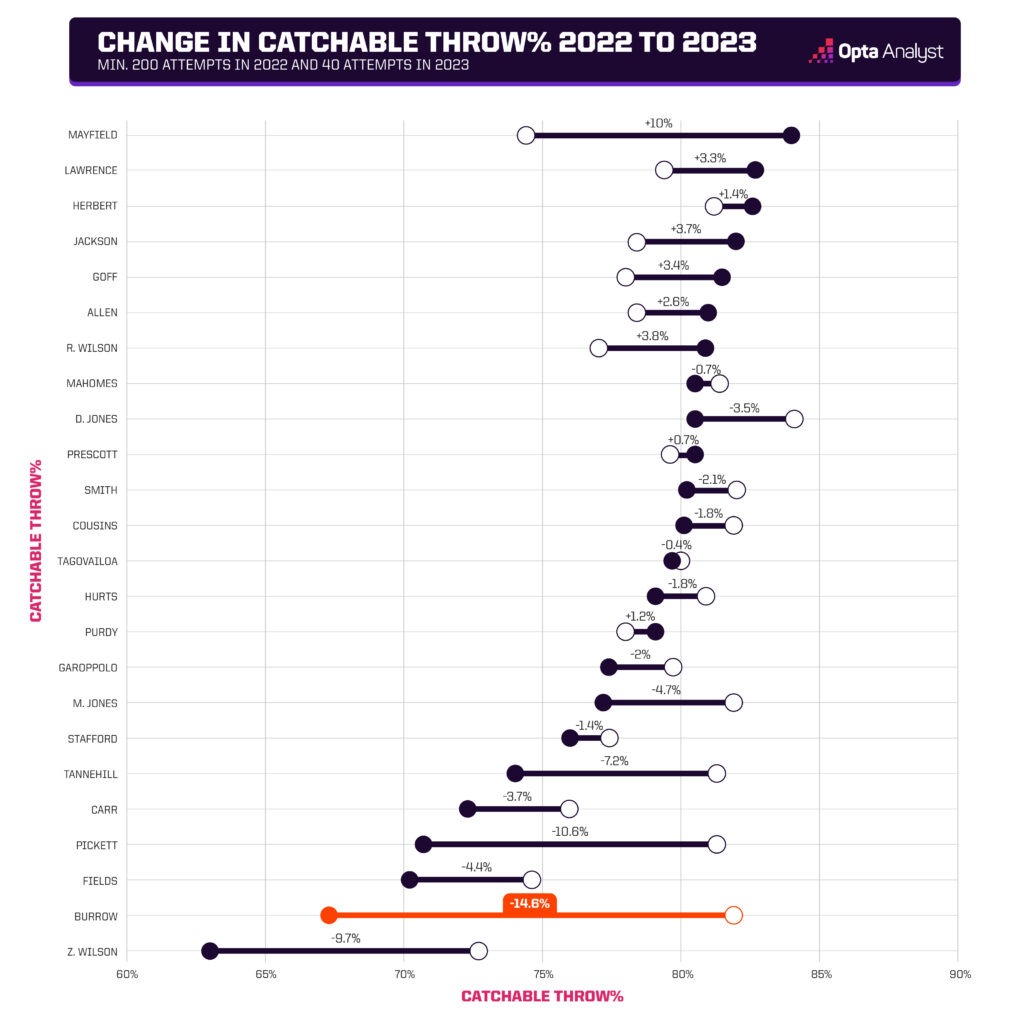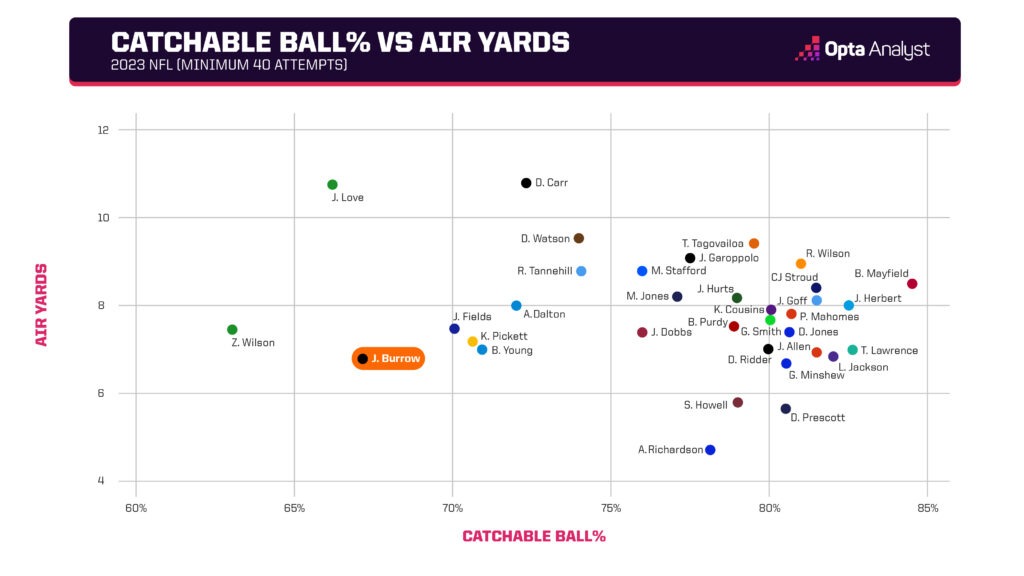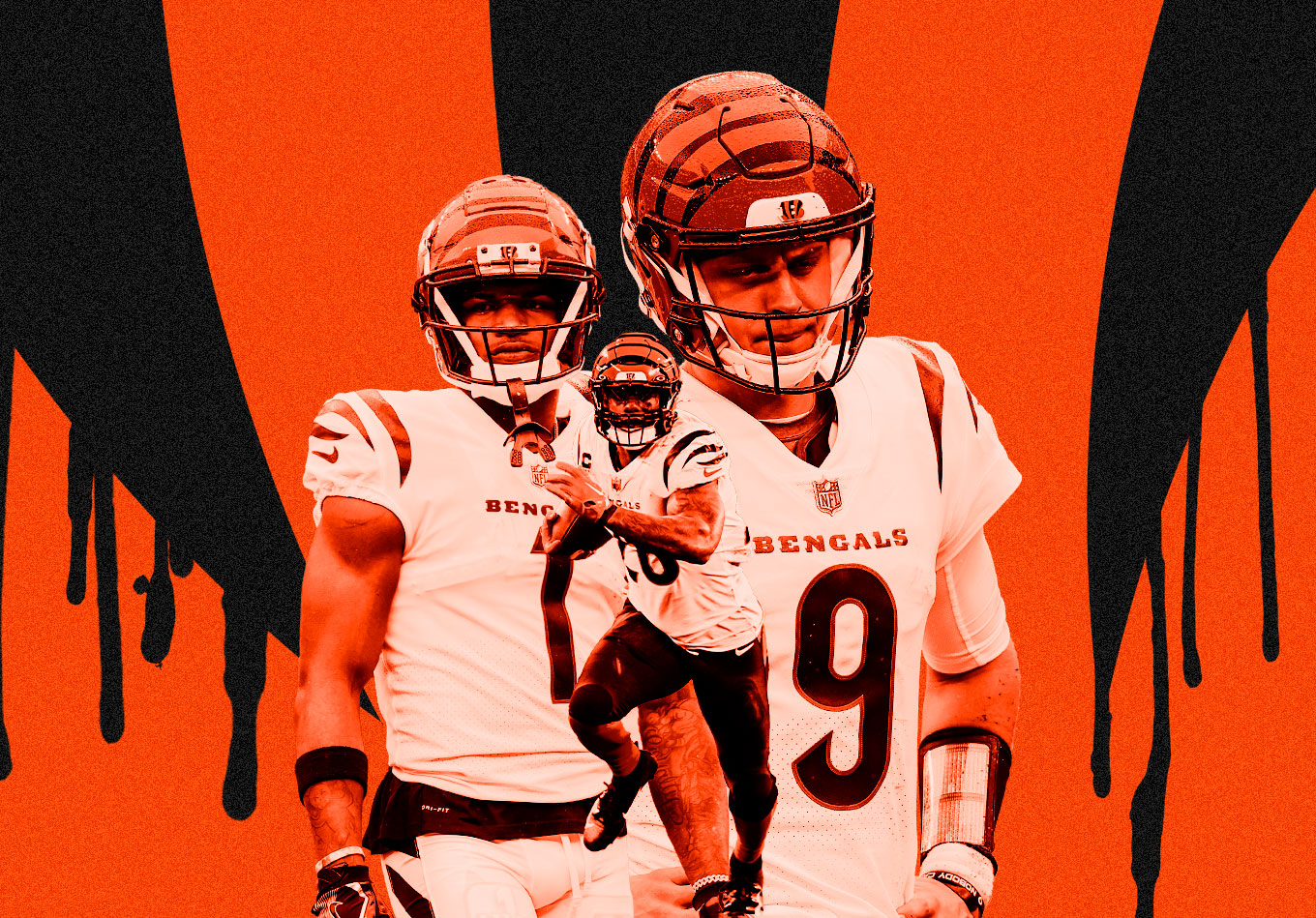After the Bengals made it to at least the AFC championship game in each of Joe Burrow’s first two full seasons as a starter, expectations were sky-high for Cincinnati’s offense, and the team as a whole, to be among the NFL’s best yet again.
But through the admittedly small sample size of three games, that has been anything but the case.
The Bengals, who started 0-2 last year before finishing 12-4, are the AFC North’s only team with a losing record heading into Week 4. They are averaging a meager 15.3 points per game (fifth lowest in the NFL) after ranking seventh with 26.1 in 2022. They have not yet put up 25 points in a game this season, something they did in nine of their 16 contests a year ago.
And all of this has come despite a relative lack of personnel turnover. Burrow and Joe Mixon are back in the backfield, as is the wide receiver trio of Ja’Marr Chase, Tee Higgins and Tyler Boyd. All in all, only two offensive starters from last year’s team are no longer with Cincinnati – tight end Hayden Hurst (Carolina) and offensive tackle La’el Collins (free agent).
So what’s up with the offense? Are there signs that the Bengals are about to turn things around, or are they destined to fulfill our model’s projection of finishing last in the AFC North?
The first thing that jumps out about Burrow’s 2023 stats might be his completion percentage, which has fallen to 55.4% after being above 65% in each of his first three seasons. But it’s long been established that completion percentage isn’t the be-all, end-all way to evaluate passing ability.
Not all completions are created equal, both in terms of how much they benefit the offense and in terms of how difficult they are to achieve. Furthermore, specific situations like dropped passes or spikes would penalize a QB’s completion percentage in cases where it’s not necessarily just.
However, Burrow has completed only 59.3% of his true pass attempts this season (i.e., any pass attempt that’s not a throwaway or a spike). Among 34 QBs with at least 40 true attempts this season, that’s the second-lowest mark, ahead of only Jordan Love’s 53.7% (entering Thursday).
This is an extremely sharp contrast to Burrow’s 70.5% from last season, and as a matter of fact, his decline of 11.2% is the largest among 25 QBs with at least 200 true attempts in 2022 and 40 in 2023. (All stats from here onward will refer to only these “true attempts.”)
Completion percentage is obviously largely dependent on one’s teammates, as any receiver still needs to haul in a pass, no matter how good it is. Using our catchable throw percentage, though, we can mitigate the impact of receivers’ catching ability. A “catchable throw” doesn’t have to be well thrown necessarily, it just needs to be in a place where the receiver has a chance at it.
So you can have poorly thrown but catchable ball (e.g., high so the receiver has to jump), or you can have a well-thrown but not catchable ball (e.g., on target but defender knocks it away). And in catchable throw rate, Burrow has fallen from 81.9% in 2022 to 67.3% in 2023, a decline of 14.6% which is by far the largest among the aforementioned 25 QBs.

A similar story is told if we look at well-thrown percentage, which is a lot like catchable throw percentage, except that it strictly evaluates the accuracy of the pass. Burrow’s well-thrown percentage is 10.4% lower in 2023 than it was a year ago. That’s the second-largest decline among the same 25 passers, trailing only Andy Dalton.
It’s worth noting that the Bengals’ drop percentage of Burrow’s passes has slightly increased (from 3.7% in 2022 to 4.4% in 2023), but needless to say, the larger issues are the sharp reductions in well-thrown passes and catchable passes altogether. Often, if a passer has a decrease in these metrics, it means he has been attempting significantly more difficult passes.
But with Burrow, this has not necessarily been the case. This season, he’s averaged 6.8 air yards per attempt. That’s the fifth-lowest among 34 QBs with at least 40 true attempts, and it’s lower than his 7.5 air yards per attempt from 2022. In a nutshell, this would not be particularly problematic, but when combined with Burrow’s declining accuracy metrics, it leads him to stand out in a negative way.
Among the 25 QBs with at least 200 true attempts in 2022 and 40 in 2023, Burrow is one of only three who have both a lower well-thrown percentage and fewer air yards per attempt than they did a year ago, joining Brock Purdy and Josh Allen.
And while three passers is already a small group, even that number is deceptive. Both Purdy and Allen’s well-thrown percentages are under 1% lower than they were in 2022 – compared to Burrow, who, as already mentioned, has declined by more than 10% in that metric.
Additionally, Burrow’s catchable throw percentage of 67.3% is the third lowest among the 34 QBs with at least 40 true attempts this year, ahead of only Love and Zach Wilson (heading into Week 4). Burrow is the only one of those 34 passers to have fewer than 7.0 air yards per attempt and a sub-70 catchable throw percentage.

Of course, none of this can be discussed without mentioning Burrow’s calf injury, which caused him to miss much of the preseason and almost led to him missing Week 3. While it’s up for debate exactly how much the injury has impacted his passing, it objectively has made a significant impact on his running.
Last season, Burrow was among the NFL’s better-running quarterbacks, finishing with a career-high 257 rushing yards and ranking in the top 10 in both scrambles (44, tied for sixth) and designed QB runs (31, eighth). This year, that’s been anything but the case. Burrow only has had one rush attempt that wasn’t a kneel down – a 5-yard scramble against the Ravens in Week 2.
If we look around the rest of the Bengals offense, what do we find? The team has an NFL-worst 28.1% success rate (percentage of plays that are a significant gain toward a first down or touchdown), so it’s worth exploring Cincinnati’s offensive personnel beyond the quarterback position.
Buoyed by the addition of four-time Pro Bowl OT Orlando Brown Jr., the Bengals rank second in the NFL in pressure-allowed rate in 2023 (25.6%), behind only Miami’s 22.9%. However, they’re second-to-last in run success rate (25.0%), ahead of only Houston’s 17.6%.
There’s no evidence that Mixon has fallen off in his seventh NFL season. His 4.0 yards per carry are a hair ahead of his 3.9 from a year ago, and he has also averaged more yards after contact per carry and more missed and broken tackles per touch in 2023 than he did in 2022. However, he’s only averaging 1.82 yards before contact (the league average is 2.28), a product of those issues up front.
As for the receiving unit, there’s more of a case for regression. Burrow’s targeted receivers have been open on only 73.5% of his attempts this season. That’s the fourth-lowest rate among the 34 passers with at least 40 true attempts. Burrow and Dak Prescott are the only passers with a sub-75 open target percentage and fewer than 7.0 air yards per attempt so far this season.
When looking at Cincinnati’s receivers individually, both Chase and Boyd have produced similar metrics in 2023 compared to 2022. Higgins, though, has been a vastly different story. Higgins was open on 69.2% of his targets in 2022, but that number has fallen all the way to 48.1% this season.
While Higgins is more known for his contested catch prowess than his ability to create separation, he’s also fallen off his 2022 standard in that regard. Higgins already has three dropped passes (after having six all of last season), and he has caught 76.9% of his catchable targets – a good chunk below his 86.6% rate from last year.
What are the biggest signs of hope going forward for Who Dey Nation? For one, Burrow’s processing has still been strong this season. His average time to throw of 2.36 seconds is among the NFL’s fastest, and he has only thrown a pickable pass on 1.8% of his true attempts, even lower than his 1.9% from last year (which was second-lowest in 2022, behind Justin Herbert).
Secondly, and most importantly, three games is a much smaller sample size than two years. Even though this season has been rough, it’s reasonable to believe that the “real Bengals” are closer to what we saw in 2021 and 2022 than what we’ve seen in 2023.
If they are going to turn it around, though, they have a lot of work to do quickly. Largely due to how well the rest of the division is playing, our model gives the Bengals only an 18.8% chance to make the playoffs, meaning Joe Brrr and company will have to overcome the odds yet again if they want to play deep into January.
